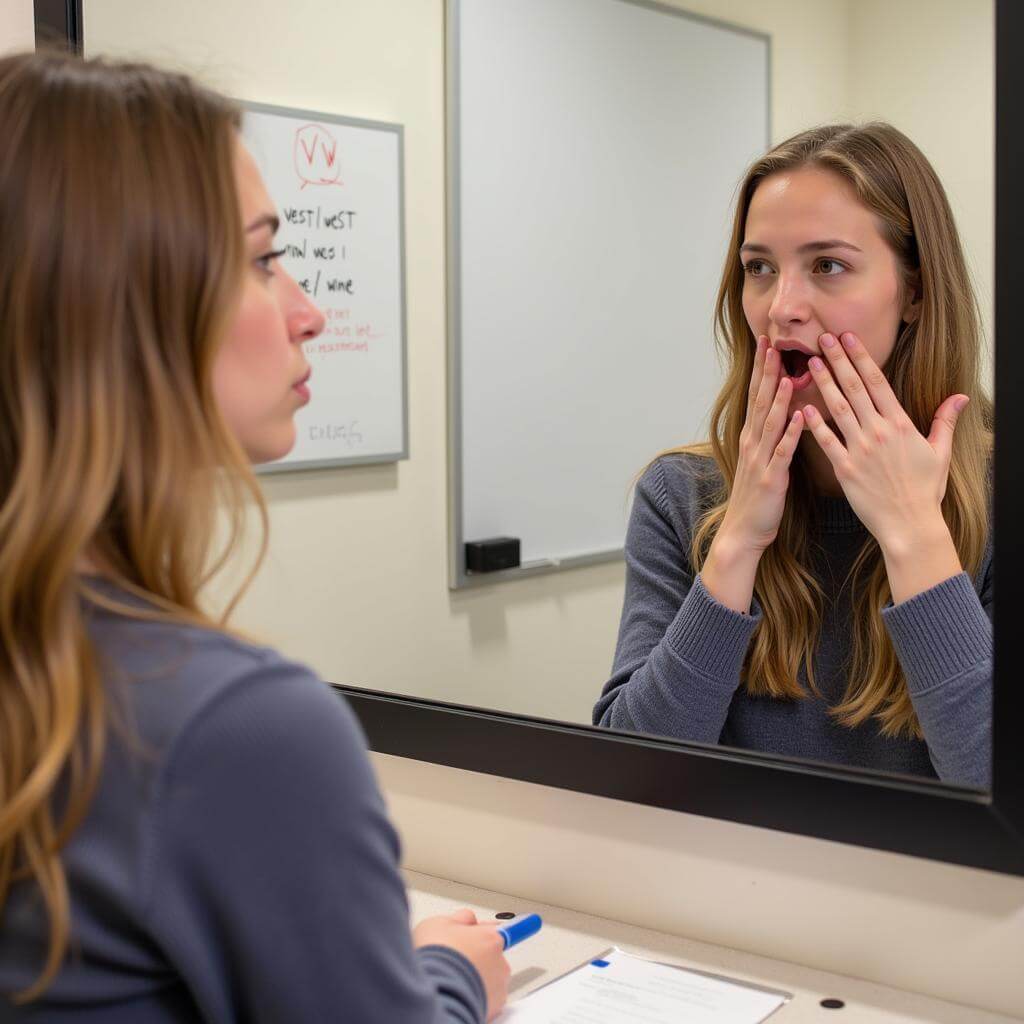Improving pronunciation for tricky sounds is a crucial aspect of IELTS preparation, especially for the Speaking test. Many test-takers struggle with certain English phonemes that don’t exist in their native languages. This comprehensive guide will provide you with effective strategies to overcome these challenges and boost your IELTS Speaking score.
Understanding the Importance of Pronunciation in IELTS
Pronunciation plays a significant role in the IELTS Speaking test, accounting for 25% of your overall score. Examiners assess your ability to produce individual sounds, use stress and intonation correctly, and speak with appropriate rhythm. Mastering tricky sounds can significantly enhance your clarity and fluency, leading to a higher band score.
Common Pronunciation Challenges for IELTS Candidates
- Th-sounds (/θ/ and /ð/)
- R-sound (/ɹ/)
- V-sound (/v/)
- W-sound (/w/)
- Schwa sound (/ə/)
- Long and short vowel distinctions
- Consonant clusters
Effective Techniques for Improving Pronunciation of Tricky Sounds
1. Mindful Listening and Mimicking
One of the most powerful ways to improve your pronunciation is through active listening and imitation. Expose yourself to native English speakers through podcasts, TV shows, and movies. Pay close attention to how they produce tricky sounds and try to replicate them.
“The key to mastering pronunciation is to train your ear first. Once you can hear the subtle differences, your mouth will follow,” says Dr. Emma Thompson, IELTS Speaking expert with 15 years of experience.
2. Using Phonetic Transcriptions and IPA
Familiarize yourself with the International Phonetic Alphabet (IPA). This tool can help you visualize the correct mouth positions for tricky sounds. Many online dictionaries provide IPA transcriptions for words, allowing you to practice accurate pronunciation.
3. Tongue Twisters and Minimal Pairs
Incorporate tongue twisters and minimal pairs into your practice routine. These exercises focus on specific sounds and help train your mouth muscles to produce them accurately.
- Tongue twister example: “The thirty-three thieves thought that they thrilled the throne throughout Thursday.”
- Minimal pair example: “van” vs. “ban”, “wet” vs. “vet”
4. Mirror Practice
Stand in front of a mirror and observe your mouth movements as you practice tricky sounds. This visual feedback can help you adjust your articulation for more accurate pronunciation.
5. Record and Analyze Your Speech
Use your smartphone or computer to record yourself speaking. Listen back and compare your pronunciation to native speakers. This self-assessment technique can help you identify areas for improvement.
Tackling Specific Tricky Sounds for IELTS
Mastering the ‘Th’ Sounds
The ‘th’ sound comes in two varieties: voiced (/ð/) as in “this” and unvoiced (/θ/) as in “think”. To produce these sounds:
- Place the tip of your tongue between your upper and lower front teeth.
- For the voiced ‘th’, add vibration to your vocal cords.
- For the unvoiced ‘th’, simply blow air out without vibrating your vocal cords.
Practice words: thank, think, those, these, breathe, bath
Perfecting the ‘R’ Sound
The English ‘r’ sound (/ɹ/) can be challenging for many non-native speakers. To improve:
- Curl the tip of your tongue back towards the roof of your mouth.
- Keep your lips slightly rounded.
- Produce the sound without rolling your tongue (unlike in some other languages).
Practice words: red, river, arrow, are, far, car
“The ‘r’ sound is often a stumbling block, but with consistent practice, it becomes second nature,” notes Professor James Clark, phonetics researcher and IELTS trainer.
Distinguishing Between ‘V’ and ‘W’
Many IELTS candidates struggle to differentiate between ‘v’ and ‘w’ sounds. Here’s how to master them:
- For ‘v’ (/v/): Place your upper teeth on your lower lip and blow air out while vibrating your vocal cords.
- For ‘w’ (/w/): Round your lips and produce a short sound, like saying “oo” very quickly.
Practice minimal pairs: vest/west, vine/wine, veil/wail

Integrating Pronunciation Practice into Your IELTS Preparation
To effectively improve your pronunciation of tricky sounds, incorporate these strategies into your daily IELTS study routine:
- Dedicate 15-20 minutes daily to focused pronunciation practice.
- Use IELTS Speaking practice questions to apply your improved pronunciation in context.
- Join language exchange groups or find a speaking partner to practice regularly.
- Utilize pronunciation apps and online resources for additional support.
- Record yourself answering IELTS Speaking questions and analyze your pronunciation.
Conclusion: Confidence Through Improved Pronunciation
Improving pronunciation for tricky sounds is a journey that requires patience and consistent practice. By implementing these expert tips and techniques, you’ll not only enhance your IELTS Speaking performance but also boost your overall confidence in English communication. Remember, clear pronunciation is key to effective communication in the IELTS test and beyond.
FAQs About Improving Pronunciation for Tricky Sounds in IELTS
-
How long does it take to improve pronunciation of tricky sounds?
Improvement timelines vary, but with dedicated daily practice, noticeable progress can often be seen within 4-6 weeks. -
Can I improve my pronunciation without a native speaker’s help?
Yes, you can make significant improvements using online resources, recordings, and self-practice techniques. However, feedback from a native speaker or qualified teacher can accelerate your progress. -
Will accent reduction help my IELTS Speaking score?
While IELTS doesn’t penalize accents, clearer pronunciation of individual sounds can improve your overall intelligibility, potentially leading to a higher score. -
Are there any quick fixes for improving pronunciation before my IELTS test?
While there are no instant solutions, focusing on the most problematic sounds and practicing minimal pairs can lead to rapid improvements in the short term. -
How important is intonation compared to individual sound pronunciation in IELTS?
Both are important. While accurate sound production is crucial, proper intonation helps convey meaning and attitude, which are also assessed in the IELTS Speaking test.